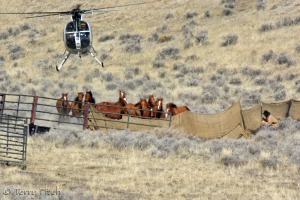Source: Elko Daily Free Press
Truth or more BLM BS?

BLM attacking what was left of Nevada’s Antelope herd ~ photo by Terry Fitch of Wild Horse Freedom Federation
Drought has prompted the Bureau of Land Management to undertake targeted action on the rangeland such as supplying wild horseswith food and water, cutting back cattle grazing and enacting fire restrictions.
Hot, dry conditions persist in the West with at least 15 states experiencing drought. In Nevada, about 60 percent of the state has been in severe or extreme drought since January.
“Since last fall and winter, we have been working with grazers across the West in anticipation of tough conditions related to drought,” said Neil Kornze, BLM principal deputy director. “In southwestern Montana, for example, the BLM worked with permitted ranchers to graze no more than 70 percent of their allotted forage on BLM-managed lands.
“As drought conditions continue, wild horses, livestock, and wildlife that rely on rangeland forage and water will face extremely challenging conditions that may leave them in very poor condition. We are taking action to address these situations as quickly and as effectively as we can, but our options are increasingly limited by conditions on the land,” he added.
All Nevada BLM districts have been hauling water to wild horses. The BLM is trucking 5,000 gallons of water per day, five days a week to four locations throughout the Winnemucca District at a cost of $1,000 per day.
In the next few days, a USDA Animal and Plant Health Inspection Service veterinarian will join BLM specialists in assessing horses in Lincoln County, after BLM employees noted horses weren’t drinking water from trucked-in troughs and were not eating supplemental hay. This raised concerns about the health of the animals.
Over the past week in Nevada average temperatures have been 10 degrees above normal, hovering around 100 degrees. That state has recently had only 0.1 to 0.5 inches of rain, resulting in sparse, poor-quality forage.
In addition, scare water sources have put pressure on all users, including wild horses, livestock and wildlife causing long-lasting damage to plant, stream channels, spring areas and water quality.








